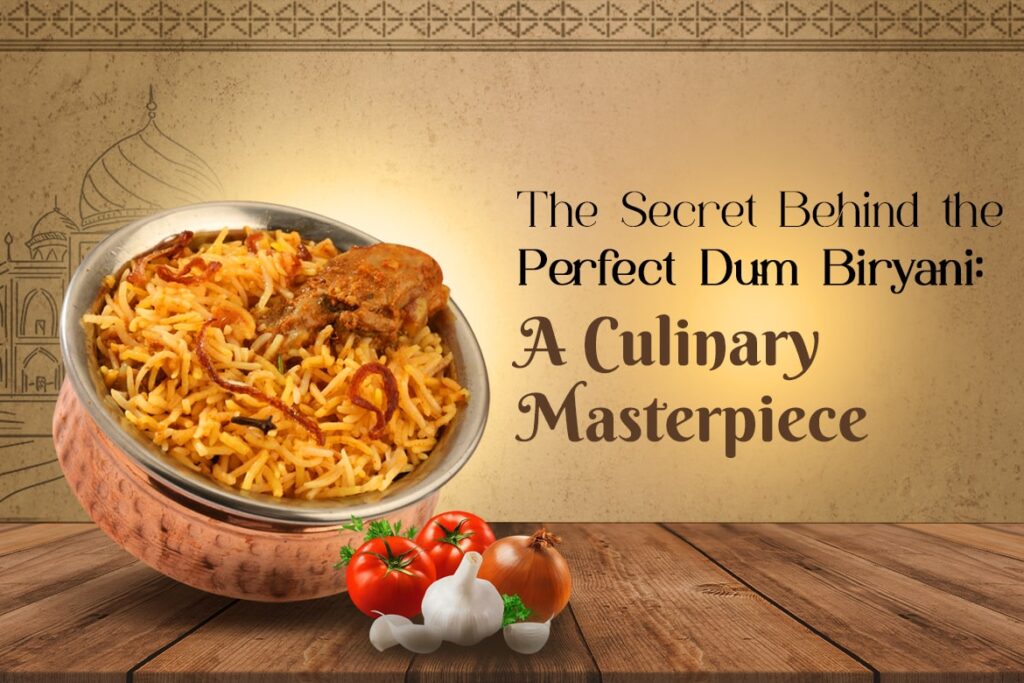Dum Biryani is more than just a dish—it’s a culinary experience that showcases the depth and richness of Indian flavors. The magic lies in its slow-cooking technique, where layers of fragrant basmati rice, marinated meat, and aromatic spices come together under sealed steam, infusing every bite with incredible taste. This traditional cooking method has made Dum Biryani famous not just in India but across the world.
The History of Dum BiryaniDum Biryani traces its roots back to the Mughal era, where royal chefs perfected this method of slow cooking. The ‘Dum’ technique involves sealing the pot with dough, allowing the ingredients to cook in their own juices, creating a deeply flavorful and aromatic dish. Today, Dum Biryani remains a staple in Indian cuisine, with variations found across regions such as Hyderabad, Lucknow, and Kolkata, each offering its unique take on this timeless dish.
Key Elements of the Perfect Dum Biryani
- Premium Basmati Rice
Long-grained, aged basmati rice is essential for achieving the fluffy, fragrant texture that defines Dum Biryani. Each grain remains separate, absorbing the essence of the spices and meat. - Marinated Meat
The secret to tender, flavorful meat lies in marination. Using a blend of yogurt, saffron, and hand-ground spices, the meat is left to absorb the rich flavors before being layered into the biryani. - Aromatic Spices
Aromatic whole spices such as cardamom, cloves, cinnamon, and star anise give Dum Biryani its distinctive depth of flavor. The balance of these spices is crucial to achieving the perfect taste. - The ‘Dum’ Cooking Technique
A slow-cooking process ensures that the flavors meld beautifully. The pot is sealed, allowing the rice and meat to cook together, resulting in a biryani that’s rich, moist, and deeply aromatic.
Regional Variations of Dum Biryani in India
- Hyderabadi Dum Biryani: Known for its intense flavors, this version uses raw marinated meat layered with rice and slow-cooked to perfection.
- Lucknowi (Awadhi) Biryani: A more subtle and aromatic version, where the meat is cooked separately before being layered with rice.
- Kolkata Biryani: Influenced by Mughlai traditions, this biryani features potatoes and boiled eggs along with fragrant rice and meat.
- Malabar Biryani: A South Indian variation that incorporates coastal flavors with ghee-rich rice and aromatic spices.
Where to Find the Best Dum Biryani in India
For an authentic Dum Biryani in India, Sankranti is the ultimate destination. Our chefs use time-honored techniques and premium ingredients to create a biryani that captures the true essence of this legendary dish. Whether you prefer chicken, mutton, or vegetarian biryani, each plate promises a feast for the senses.
Experience the Art of Dum Biryani
A plate of Dum Biryani is more than just a meal—it’s a celebration of flavors and tradition. Whether you prefer a spicy Hyderabadi version or a mild Lucknowi style, Dum Biryani continues to be one of India’s most cherished culinary treasures. Indulge in the perfect blend of spices, aroma, and taste, and discover why this dish has stood the test of time.
faqs
Is biryani Arab or Indian?
Biryani has roots in both Indian and Persian (Arab-influenced) cuisine. It is believed to have originated from Persian pilaf and was introduced to India by the Mughals, where it evolved into different regional variations. Today, it is an integral part of Indian cuisine.
What does biryani taste like?
Biryani is a flavorful dish with a perfect balance of aromatic spices, tender meat, and fragrant rice. It has a rich, slightly smoky taste with hints of saffron, ghee, and slow-cooked spices like cardamom, cinnamon, and cloves.
How do you pronounce Indian biryani?
Biryani is pronounced as “bir-yah-nee” (बिरयानी in Hindi), with a soft “r” and a slight emphasis on the second syllable.
What is biryani called in English?
There is no exact English translation for biryani, but it is commonly referred to as “spiced rice with meat” or simply “biryani.”
What nationality is biryani?
Biryani is considered Indian due to its deep cultural and culinary significance, but it has Persian and Mughal influences in its origin.
Why is red cloth used in biryani?
In some regions, a red cloth is used to cover biryani pots during cooking to trap heat and ensure even steaming (“Dum” cooking method). It is also used for serving as a sign of tradition and respect in South Asian cuisine.
What is the secret ingredient for biryani?
The secret ingredient varies by recipe, but saffron, kewra (pandan) water, and slow-cooking on Dum are key elements that enhance the authentic taste and aroma.
Which religion invented biryani?
Biryani was popularized by the Mughal Empire, which was predominantly Muslim, but it has been adapted and enjoyed by people of all religions across South Asia.
What is biryani called in Saudi?
In Saudi Arabia, biryani is commonly known as “Kabsa“, which is a spiced rice dish with similarities to biryani but has distinct Arabian flavors.
Why is biryani so popular?
Biryani is loved for its rich flavors, aromatic spices, and versatility. It can be made with different meats, vegetables, and spices, making it a favorite dish across various cultures and regions.








